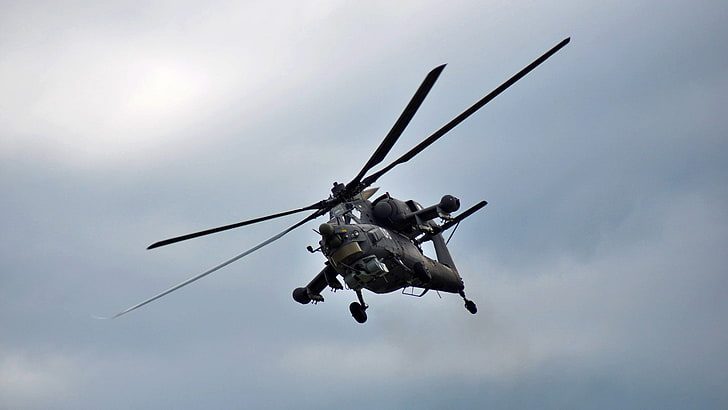The Ugandan Air Force has praised the performance of the Russian-made Mi-28N Havoc attack helicopter on the battlefield against the Lord’s Resistance Army (LRA) during the graduation ceremony of its pilots and engineers. The Mi-28N Havoc has proven to be an invaluable asset to the Ugandan Air Force, helping to ensure the safety of Ugandan citizens and the security of the nation. The power and precision of the Mi-28N Havoc have enabled the Air Force to take on the LRA with a highly effective offensive capability.
The Ugandan Air Force has also graduated pilots and engineers trained to operate and maintain the Mi-28N Havoc. This skilled personnel have demonstrated expertise in the aircraft’s systems, allowing them to make the most of its capabilities in combat. This has enhanced the Ugandan Air Force’s ability to protect its citizens and maintain the security of the nation.
Speaking on behalf of the Chief of Defence Forces General Wilson Mbasu Mbadi, Lt Gen Okidi commended the trainees for the good discipline and resilience that they exhibited since the training started and urged them to ensure the safety of the newly acquired strategic assets. He applauded the pilots for their job in providing air power during operations. “There is no doubt that the introduction of the attack helicopters into the battlefield changed the tides of war in Northern Uganda against the Lord’s Resistance Army (LRA) in favour of the UPDF and continues to do so in the subsequent operations. So, with the acquisition of New Air Assets, we are ready to serve our beloved country more in that capacity,” remarked Lt Gen Okidi.

Lt Gen Okidi reaffirmed the Air Force’s capacity to provide the much-needed Airpower that the joint operations require since it is mandated to provide and give support to the ground forces and this can only be achieved through continuous training.
The Mi-28N Havoc attack helicopter has also been instrumental in providing effective close air support to ground forces in the fight against the LRA. Thanks to its agility and firepower, the Mi-28N Havoc has been able to quickly respond to requests for assistance and provide critical fire support to ground forces. The helicopter’s advanced targeting systems and powerful armaments have enabled the Ugandan Air Force to engage enemy positions with accuracy and effectiveness.
Uganda acquired three of the Mi-28N Havoc helicopter in June 2022, as part of a first batch, with a subsequent batch expected to be delivered later this year.
The Mi-28N Havoc attack helicopter has also been credited with saving lives in the fight against the LRA. By rapidly responding to requests for assistance, the Mi-28N Havoc has been able to reduce casualties and protect ground forces from enemy fire. Its powerful armaments and advanced targeting systems have enabled the Ugandan Air Force to neutralize enemy threats quickly and efficiently.
The Mi-28N Havoc attack helicopter has proven to be an invaluable asset to the Ugandan Air Force, allowing them to protect their citizens from the LRA and maintain the security of the nation. With the successful graduation of pilots and engineers trained to operate and maintain the aircraft, the Ugandan Air Force is now well-equipped to continue its mission of defending the nation.
The Mi-28 Havoc combat helicopter was developed by Mil Moscow Helicopter Plant and its unit cost is around $18 million. It made its first flight in 1982. It is specially designed to endure extremely hot temperatures and remain operable in any geographical and climatic conditions, day and night (through the use of a day/night surveillance sighting system and an on-board radar), and in adverse weather conditions, all the while having extraordinary combat survivability systems for helicopter and crew. These include a self-defence system against heat seeker missiles, armour protection for the cockpit, and vital systems and components. The fuel tanks have special protection, and at the same time provide for a long flight with a significant weapons load.
The Mi-28 can be armed with a mixture of air-to-air and air-to-ground missiles, unguided rockets, and podded guns. The Mi-28 and Mi-28N Night Havoc are armed with Shturm and Ataka anti-tank missiles supplied by the Kolumna Design Bureau (KBM). Up to 16 anti-tank missiles can be mounted on the helicopter. Shturm is a short-range, radio command-guided missile.
The Mi-28 has a fully armoured cabin, including a windshield. The helicopter is equipped with a turreted 2A42 30mm cannon, stabilised in two axes, with a muzzle velocity of 1,000m/s. Mi-28 can fly at a maximum speed of 300km/h, can fly rearwards and sideways at speeds up to 100km/h and is able to hover turn at 45° a second.
The Mi-28 attack helicopter is in use by Algeria, Russia, and Iraq.
In January last year, Uganda commissioned a new helicopter maintenance, repair and overhaul (MRO) facility at Nakasongala Air Base in preparation for the arrival of the Mi-28 Night Hunter.
The MRO plant which was commissioned by President Yoweri Museveni will target the entire African helicopter MRO market including helicopters in use by UN Missions. The MRO facility will help Uganda save about 3.5 million US dollars that have been spent on transportation and overhauling one helicopter outside Uganda.
